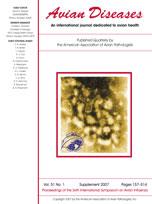To assess the potential of quail as an intermediate host of avian influenza, we tested the influenza A/Mallard/Potsdam/178-4/83 (H2N2) virus to determine whether through adaptation a mallard strain can replicate and transmit in quail, as well as other terrestrial birds. After five serial passages of lung homogenate a virus arose that replicated and transmitted directly to contact cage mates. To test whether adaptation in quail led to interspecies transmission, white leghorn chickens were infected with the wild-type (mall/178) and quail-adapted (qa-mall/178) viruses. The results show that mall/178 H2N2 does not establish an infection in chickens nor does it transmit, while qa-mall/178 H2N2 infects and transmits to contact chickens causing clinical signs like depression and diarrhea. Completed sequences indicate six amino acid changes spanning four genes, PB2, PB1, HA, and NP, suggesting that the internal genes play a role in host adaptation. Further adaptation of qa-mall/178 in white leghorn chickens created a virus that replicated more efficiently in the upper and lower respiratory tract. Sequence analysis of the chicken-adapted virus points to a deletion in the neuraminidase stalk region.
How to translate text using browser tools
1 March 2007
Adaptation of Influenza A/Mallard/Potsdam/178-4/83 H2N2 Virus in Japanese Quail Leads to Infection and Transmission in Chickens
E. M. Sorrell,
D. R. Perez
ACCESS THE FULL ARTICLE

Avian Diseases
Vol. 51 • No. s1
March 2007
Vol. 51 • No. s1
March 2007
Adaptation
avian influenza
chickens
H2N2 virus
intermediate host
quail
transmission




